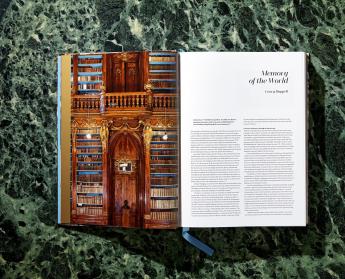News & Updates
"Temples of Knowledge" & The Love of Books Part 1 of 3

The World's Most Beautiful Libraries - Temples of Knowledge by Massimo Listri
TASCHEN, 2018
From the mighty halls of ancient Alexandria to the coffered ceilings of the Morgan Library in New York, human beings have had a long, enraptured relationship with libraries. Like no other concept and like no other space, the collection of knowledge, learning, and imagination offers a sense of infinite possibility. It’s the unrivaled realm of discovery, where every faded manuscript or mighty clothbound tome might reveal a provocative new idea, a far-flung fantasy, an ancient belief, a religious conviction, or a whole new way of being in the world.
In this new photographic journey, Massimo Listri travels to some of the oldest and finest libraries to reveal their architectural, historical, and imaginative wonder. Through great wooden doors, up spiraling staircases, and along exquisite, shelf-lined corridors, he leads us through outstanding private, public, educational, and monastic libraries, dating as far back as 766. Between them, these medieval, classical, baroque, rococo, and 19th-century institutions hold some of the most precious records of human thought and deed, inscribed and printed in manuscripts, volumes, papyrus scrolls, and incunabula. In each, Listri’s poised images capture the library’s unique atmosphere, as much as their most prized holdings and design details.
Featured libraries include the papal collections of the Vatican Apostolic Library, Trinity College Library, home to the Book of Kells and Book of Durrow, and the holdings of the Laurentian Library in Florence, the private library of the powerful House of Medici, designed by Michelangelo. With meticulous descriptions accompanying each featured library, we learn not only of the libraries’ astonishing holdings—from which highlights are illustrated—but also of their often lively, turbulent, or controversial pasts. Like Altenburg Abbey in Austria, an outpost of imperial Catholicism repeatedly destroyed during the European wars of religion, or the Franciscan monastery in Lima, Peru, with its horde of archival Inquisition documents.
Reading Art: Art for Book Lovers
by David Trigg
PHAIDON, 2018
A celebration of artworks featuring books and readers from throughout history, for the delight of art lovers and bibliophiles.
As every book tells a story, every book in art is part of an intriguing, engaging, and relatable image. Books are depicted as indicators of intellect in portraits, as symbols of piety in religious paintings, as subjects in still lifes, and as the raw material for contemporary installations. Reading Art spotlights artworks from museums and collections around the globe, creating a gorgeous, inspiring homage to both the written word and to its pivotal role in the visual world.
"Gathers together in one place the paintings and artworks through history that capture books as a thing of beauty. Reading Art: Art for Book Lovers, written by David Trigg, will have you putting down your latest page turner to gawp at the stunning ways different artists have captured the act of getting lost in a good book..." Evening Standard
Making Medieval Manuscripts by Christopher De Hamel
Bodleian Publishing, 2017
Based principally on examples in the Bodleian Library, this lavishly illustrated account tells the story of manuscript production from the early Middle Ages through to the high Renaissance. Each stage of production is described in detail, from the preparation of the parchment, pens, paints and inks to the writing of the scripts and the final decoration and illumination of the manuscript. This book also explains the role of the stationer or bookshop, often to be found near cathedral and market squares, in the commissioning of manuscripts, and it cites examples of specific scribes and illuminators who can be identified through their work as professional lay artisans.
The Gutenberg Bible - Volume I by Stefan Füssel
TASCHEN, 2018
The printing press has been called the greatest invention of the second millennium. Published in Mainz around 1454, the Gutenberg Bible was the first major Western publication to be printed with movable metal type, ushering in a whole new age of knowledge distribution through mass-produced books.
Before Gutenberg, woodcut printing and early forms of movable type printing had been mastered in Asia, but had yet to reach Europe. Instead, each book had to be copied by hand in a long, labor-intensive process. Not only did Gutenberg’s innovation of mechanical movable type significantly speed up production without sacrificing quality, it irreversibly enriched public knowledge, pioneering mass communication and allowing people to access ideas and participate in discussions like never before.
This facsimile edition derives from one of the very few surviving complete vellum Latin originals worldwide; the Göttingen Library edition, one of the most valuable books in the world, listed in the UNESCO Memory of the World program. All 1,282 pages of this artistic and technological masterwork are included, along with a companion book written by Stephan Füssel, Gutenberg-Chair at Mainz University, introducing Gutenberg, his transformative influence, and two important documents of the time: the Göttingen Model Book which was used to illuminate the Göttingen Library edition and the only surviving notary document by Ulrich Helmasperger, which records the history of this unique invention and its product, the Gutenberg Bible.
